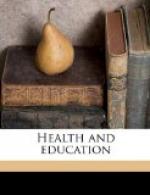Now, it befel me that, fresh from the Tropic forests, and with their forms hanging always, as it were, in the background of my eye, I was impressed more and more vividly the longer I looked, with the likeness of those forest forms to the forms of our own Cathedral of Chester. The grand and graceful Chapter-house transformed itself into one of those green bowers, which, once seen, and never to be seen again, make one at once richer and poorer for the rest of life. The fans of groining sprang from the short columns, just as do the feathered boughs of the far more beautiful Maximiliana palm, and just of the same size and shape: and met overhead, as I have seen them meet, in aisles longer by far than our cathedral nave. The free upright shafts, which give such strength, and yet such lightness, to the mullions of each window, pierced upward through those curving lines, as do the stems of young trees through the fronds of palm; and, like them, carried the eye and the fancy up into the infinite, and took off a sense of oppression and captivity which the weight of the roof might have produced. In the nave, in the choir the same vision of the Tropic forest haunted me. The fluted columns not only resembled, but seemed copied from the fluted stems beneath which I had ridden in the primeval woods; their bases, their capitals, seemed copied from the bulgings at the collar of the root, and at the spring of the boughs, produced by a check of the redundant sap; and were garlanded often enough like the capitals of the columns, with delicate tracery of parasite leaves and flowers; the mouldings of the arches seemed copied from the parallel bundles of the curving bamboo shoots; and even the flatter roof of the nave and transepts had its antitype in that highest level of the forest aisles, where the trees, having climbed at last to the light-food which they seek, care no longer to grow upward, but spread out in huge limbs, almost horizontal, reminding the eye of the four-centred arch which marks the period of Perpendicular Gothic.
Nay, to this day there is one point in our cathedral which, to me, keeps up the illusion still. As I enter the choir, and look upward toward the left, I cannot help seeing, in the tabernacle work of the stalls, the slender and aspiring forms of the “rastrajo;” the delicate second growth which, as it were, rushes upward from the earth wherever the forest is cleared; and above it, in the tall lines of the north-west pier of the tower—even though defaced, along the inner face of the western arch, by ugly and needless perpendicular panelling—I seem to see the stems of huge Cedars, or Balatas, or Ceibas, curving over, as they would do, into the great beams of the transept roof, some seventy feet above the ground.
Nay, so far will the fancy lead, that I have seemed to see, in the stained glass between the tracery of the windows, such gorgeous sheets of colour as sometimes flash on the eye, when, far aloft, between high stems and boughs, you catch sight of some great tree ablaze with flowers, either its own or those of a parasite; yellow or crimson, white or purple; and over them again the cloudless blue.




